I visited Iceland amid volcanic eruption fears and earthquake chaos… Grindavik has literally been torn in half, writes DAVID JONES
My feet are on either side of a jagged crack, zigzagging across the asphalt. Here it’s quite narrow, but further along the road it becomes a yawning 10-foot-wide chasm, and as I stare into the steaming black void it’s as if I can see the bowels of the earth.
About 500 meters away lies a boiling river of molten lava with many winding tributaries. For centuries it has been conveniently located at the planet’s core, but in recent weeks it has risen inexorably.
As you read this, it is trying to summon the energy and find the underground pathways that will facilitate its eventual journey through the surface.
And if, heaven forbid, this seething torrent erupts – as many experts fear it will soon – the remote fishing port of Grindavik, on Iceland’s south-west coast, will go the way of Pompeii, Tiwanaku and those other volcano-obliterated remains of ancient history.
As of now, this quaint little outpost remains a ghost town. This has been the case since Friday, when – with a thunderous roar that resembled the sound of low-flying fighter jets crashing through the sound barrier – a terrifying earthquake struck, forcing the emergency evacuation of the 4,000 residents.
A police officer stands near the crack in a road in the fishing village of Grindavik, which was evacuated on Wednesday due to volcanic activity in Iceland
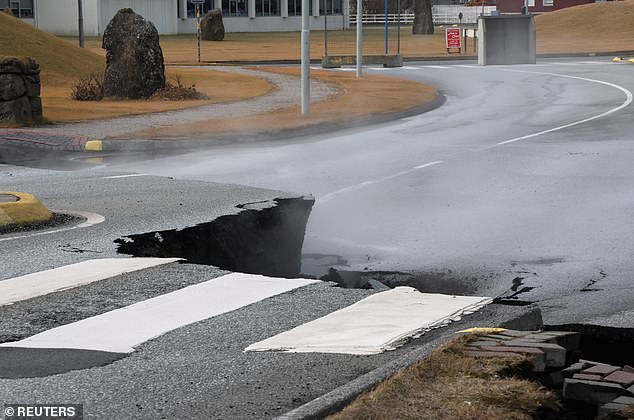
A road was damaged in the village of Grindavik, which was evacuated on Tuesday due to volcanic activity, in Iceland
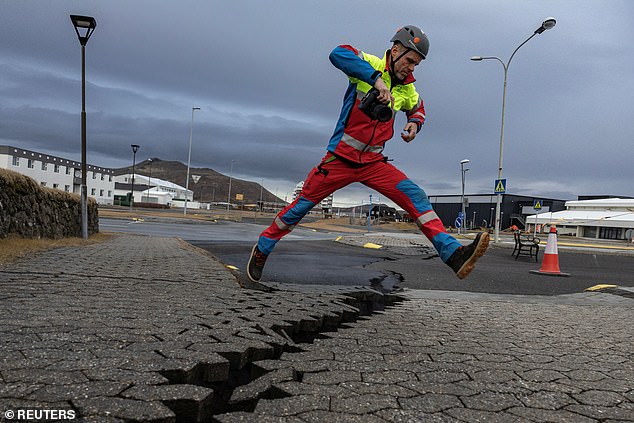
A search and rescue team member jumps over the crack in a road in Grindavik
Entering Grindavik yesterday under a police escort was a strange and nerve-wracking experience. Leaving the last checkpoint, we drove through an eerie lunar landscape of low, lichen-covered hills and craters formed by the last major eruption here, 2,400 years ago.
The land is treeless and dark, pierced by bubbling gray cauldrons belching steam. But the largest plume, like that of a former railway locomotive, comes from a huge geothermal power plant that supplies much of the energy in southern Iceland. Workers are racing against the clock to surround it with a wall that could protect it from the impending lava wave.
As we reached the edge of town we passed abandoned fish salt factories, empty playgrounds, abandoned houses and cars.
It was as if all the clocks here had stopped on a Friday evening when the alarm went off and people were given a few minutes to grab their essentials before fleeing for their lives.
Earlier yesterday, 50-year-old Grindavik resident Gudrun Eyjolfsdottir, who had just returned from work in the capital Reykjavik when the earthquake struck, had eloquently described what it felt like.
“We’re used to small earthquakes here, but this one was very different,” the prosthetics technician told me, as her car idled in the endless diaspora queue, waiting for permission to return home to collect their last few prized possessions (in her case, a traditional Icelandic costume handed down from her great-grandmother).
‘Usually the ground shakes a little, but this was like a ship in a terrible storm, tossing us up and down and to one side.
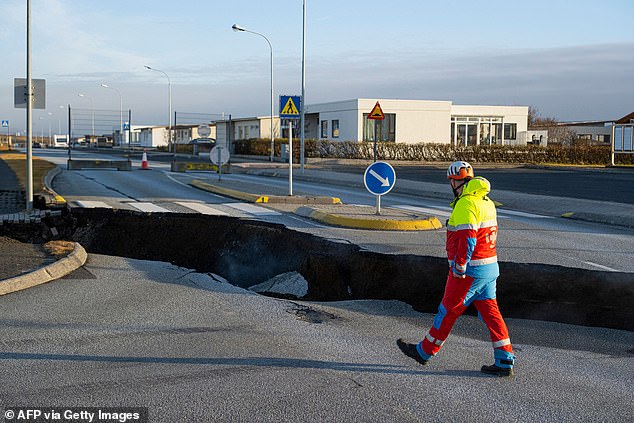
An emergency services member walks past a crack in a main road
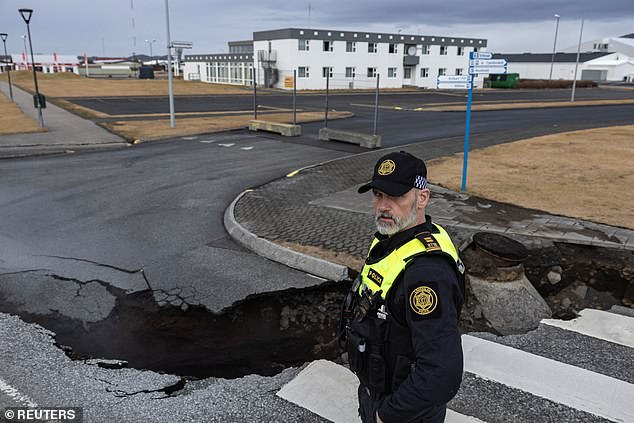
A police officer stands at the crack in a road in Grindavik today
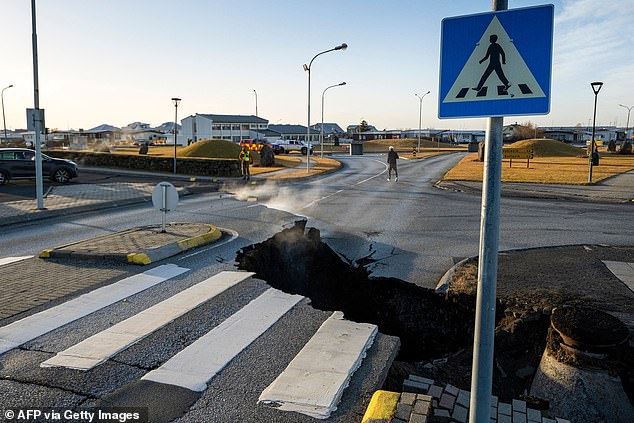
A crack cut through the main road in Grindavik on Monday
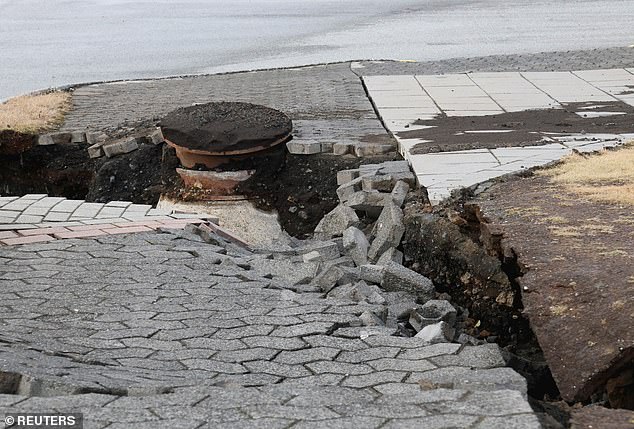
A road has been damaged in the village of Grindavik, which was evacuated due to volcanic activity
‘As I walked into my flat, a heavy wardrobe fell on me. Luckily it wedged itself against the door; otherwise I would have been crushed.”
Similar stories of near misses had been retold as I walked along the traffic line.
But it wasn’t until I entered the Red Zone – the now fenced-off area in the city center that suffered the worst destruction – that I understood the fear they must have endured.
Here Grindavik is literally torn in two, as one of the main roads through the town runs above a fault line deep in the earth’s crust.
Not only has it split into pieces, it has also fallen several feet, so that it now looks like the edge of a treacherous abyss.
Strangely enough, the deepest and widest ditch is directly above a crosswalk: a usually safe path used by children attending kindergarten just 350 meters away, and by congregants of a beautiful nearby church.
If they had been walking to school when the earth opened up and spewed jets of boiling water from the geothermal heating pipes, they would surely have been swallowed or burned. That it was torn apart late in the afternoon, when the school was closed and the nearby supermarket, gym and offices emptied, is a small mercy to which the locals – resilient people who call themselves ‘Grindvikings’ – cling.
And they need all the grace they can get. Although the scenes I witnessed yesterday were grim, my guide, Police Sergeant Stefan Velamir, said the damage was worse in another area, too unstable to visit, where houses had sagged and fallen apart like buildings made from Lego blocks.
As dusk fell, the young police officer led me back to the Land Cruiser.
As we spoke, he said gravely, the sidewalk continued to slowly slide, sinking a few inches every day. It was time to leave. Looking back at the steaming fissure, I asked him whether, even if the fissure volcano spreading its tentacles beneath us did not erupt anytime soon, anyone could confidently return to live here again.
He gave an uncertain but optimistic answer. Back in the capital, however, an expert volcanologist offered a more realistic picture, saying it would take many years of geological quiescence before anyone could rule out the possibility of an eruption.
So the benighted Grindvikings are caught between a rock and a hard place.
As they rely on the charity of family members, friends and a host of strangers who have given them a new home, it will take all their stoicism to get through it.
